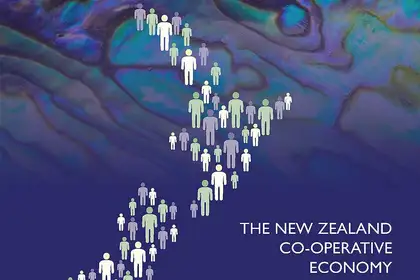
New report on the co-operative economy.
New Zealand’s co-operative economy has been comprehensively mapped for the first time, revealing the significance of the sector in terms of revenue, jobs, and membership, as well as obvious differences between New Zealand’s and other co-operative economies.
A new report finds the co-operative sector contributes revenues of more than $42.3 billion per annum and New Zealand’s Top 30 co-operatives and mutuals are responsible for 1.4 million memberships, employment of 48,500 people, and a revenue to GDP ratio of 17.5 per cent.
Co-operatives and mutuals are organisations owned and controlled by their members and who distribute benefits based on use/patronage. Examples include Fonterra, Foodstuffs, Ballance Agri-Nutrients, Farmers Mutual Group, and Southern Cross Healthcare Society.
Lead researcher Dr Elena Garnevska of Massey University says, “The results are a much-needed glimpse into a sector of significant economic and social importance to the country and help us to better understand and promote the cooperative business model to policy-makers, consultants and other stakeholders.
“With 1.4 million memberships the results show how much the co-operative economy is woven into the everyday lives of New Zealanders.”
The report – a collaboration between the sector body, Cooperative Business New Zealand and researchers from Massey University and the University of Auckland - shows New Zealand’s Top 30 co-operatives and mutuals are very strong in agri-food, accounting for 65.2 per cent of revenue, 67.6 per cent of assets, and 82.8 per cent of employment in the co-operative economy.
The next largest sector by revenue is retail and wholesale, accounting for 30.3 per cent.
Strikingly, the agri-food and retail and wholesale sectors account for twice as much of New Zealand’s co-operative economy compared to the World’s Top 300 co-operatives and mutuals and three times that of Australia’s Top 100.
Dr Garnevska says, “We expected the agrifoods sector would be important but we were surprised to find it is twice as much as the global situation.”
The study also revealed significant differences in New Zealand’s insurance, banking, and finance sectors compared to overseas trends. Globally, the insurance, banking, and finance sector accounts for 45 per cent of revenue in the cooperative economy, whereas in New Zealand, it is only 3.4 per cent.
The report identifies a wide variety of ways that New Zealand’s co-operatives and mutuals contribute to the county, through their development and empowerment of people, finding new ways to sustain growth in an uncertain and rapidly changing environment, and putting environmental and social impacts at the heart of their business.
Various awards for excellent consumer, employer, and health and safety practices, profitability over extended periods, and leadership of both social and environmental initiatives illustrated these contributions.

Lead researcher Dr Elena Garnevska.
A report people can use
The authors hope the report will raise the profile of co-operatives and mutuals in New Zealand and fuel more research within the co-operative sector.
University of Auckland researcher Dr Lisa Callagher says, “Currently New Zealand does not have a research centre with a clear focus on co-operatives and mutuals to co-ordinate and deliver research and training support, but these centres are common in other countries.
“This study provides a broad snapshot and a solid platform to develop new training and education courses. But more research and education is needed to pinpoint strengths, opportunities and evolving needs. Future research could look at the sustainability of the co-operative business model and map long-term trends and cycles”, she says.
The report, The New Zealand Co-operative Economy, was commissioned by Cooperative Business New Zealand
Co-operative Business New Zealand’s Chief executive, Craig Presland says “With almost one fifth of New Zealand’s GDP being generated by the co-operative sector, and almost 50,000 kiwis employed by co-operatives and mutuals in this country, this confirms the importance of the co-operative business model to New Zealand as a country.
“The co-operative ethos of working together collaboratively for the common good is part of who we are as New Zealanders, and as our new Prime Minister remarked at an industry forum last year: ‘Co-operatives are the business model that has stood the test of time’. We now have the opportunity to extend our research on co-operatives, and advocate even more strongly for them, so that we ensure this enduring and sustainable business model is better understood and more widely utilised across NZ business.”
The study was funded by Fonterra (lead sponsor), Ballance Agri-Nutrients, CDC Pharmaceuticals, Co-op Money NZ, Farmlands, Farmers Mutual Group, Foodstuffs – South Island, Market Gardeners, Mitre 10, Ravensdown and Silver Fern Farms.
Key findings:
Revenue:
Fonterra Co-operative Group (18.8 billion)
Foodstuffs - North Island (6.2 billion)
Foodstuffs - South Island (2.7 billion)
Silver Fern Farms (2.4 billion)
Farmlands Trading Society (2.2 billion)
Revenue by category:
Agri-food (65.2 per cent)
Wholesale and retail (30.3 per cent)
Insurance, banking and finance (3.4 per cent)
Other services (1.1 per cent)
Assets:
Fonterra Co-operative Group (18.3 billion)
Southland Building Society (SBS Bank) (2.8 billion)
Foodstuffs -North Island (2.6 billion)
The Co-operative Bank (1.8 billion)
Foodstuffs - South Island (1 billion)
Employees:
Fonterra Co-operative Group (22,000)
Silver Fern Farms (7,000)
Alliance Group (4,700)
Eastpack (2,700)
Foodstuffs - North Island (1,800)
Total membership:
Southern Cross Medical Care Society (811,462)
Co-op Money NZ (including its members’ members) (190,000)
The Co-operative Bank (120,000)
Farmlands Trading Society (62,500)
FMG (FMG Insurance Limited) (52,000)